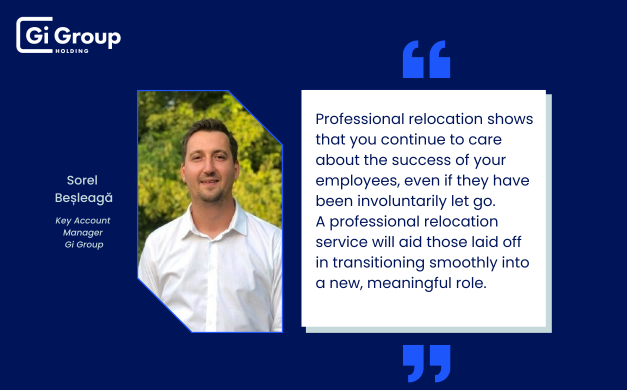Outplacement is a simple solution that helps negate the possibility of a tarnished employer brand. Basically, you need to roll out the red carpet for those being let go. Treat them well by helping them with their transition as much as possible. The best way to help is by offering outplacement alongside with a strong severance package. In this way, they will have the tools needed to succeed and a lump payment to help smooth out the job search process.
First of all, outplacement is a way to show that you still care about the success of your employees even though they have went through an involuntary termination. It’s not the fault of your employees that they have been let go, which means it’s also not their fault that they now have to find a new job before their severance payment runs out or that they have to take on a smaller job that is just meant to pay the bills and not further their careers.
With all that said, outplacement provides a pathway to a new, meaningful role, allowing workers to get back to work faster and in a role that they truly want to be in. It’s one of the best things a company can give their staff members during a layoff or reduction in force.
Sure, a strong severance package is a great start, but providing outplacement services alongside the payment really rounds out the package and allows employees to flourish instead of flounder.
These are obviously the impacts outplacement can have on employees, but you still may be wondering how this impacts the organization. Let’s explore that now.
Investment: Employer Branding, Retention, and More
There are few key factors that make outplacement a sensible business decision for employers. The first is employer brand protection.
Let’s look at an example.
Say that a person who works for a company is let go due to budget cuts. They are laid off following typical layoff procedure and have been given a severance agreement and payment that is based on the length of time they were employed.
However, they are now struggling to find new work. Their payment is running out. Their life has been turned upside down. All of that leads to strong negative feelings about the organization that let them go.
What do people do when they feel that strongly in today’s world? They tell people about it. Word of mouth is super powerful (when it’s positive or negative). This means that scorned ex-employees can start to tarnish your employer brand by telling other people to not work for your company or telling their friends and family to not buy your products.
In today’s world, word of mouth is amplified by the internet. Sites like Glassdoor and other employer review sites make it simple to report bad practices at businesses that they’ve worked at. This can be disastrous for a company.
As a refresher, employer branding is what people say about working for your business. Companies that have a strong employer branding helps them attract and retain key talent for a long time.
Why you should choose an Outplacement Provider?
An outplacement will help laid off workers get back to work in a new, meaningful role.
The approach taken to achieve this end result can differ quite a bit, though. For example, outplacement provider onboard participants by having them visit their offices or attend a webinar. After this initial meeting, outplacement provider typically work with clients for a set period of time. This is called a term limit. The provider will work with participants for a few months, providing them also in-person support.
Sometimes, this process doesn’t go very well. For instance, if a rural company has to layoff an entire manufacturing plant, it doesn’t add up that those workers have to travel to the nearest large city to receive outplacement support. This is how the internet has changed the game.
Nowadays, outplacement providers utilize the powers of modern technology to provide support to workers across the country and even the world, so they allow participants to choose if they want in-person meetings or to meet virtually. The vast majority of participants prefer virtual, because they are free to use outplacement services from the comfort of their own home anything they want to. Some participants may take up a part-time role, for example, to help ease the transition, meaning that they need/want support in the evening. Virtual delivery makes that possible.
It is important that outplacement provider understands how the current job market works and how to work with employees of all experience levels.
Let’s take an example. Say an entry level employee that was laid off wants to find a new role at the same experience level. This job search may be successful in about 1-2 month term limit. However, imagine a person that has a lot of experience in a specific role and wants to actually move up a level. This job search can take quite a bit longer. The same can be said for C-level executives who want another C-level role.
Now let’s take a look at how the process actually works.
The Outplacement Process
After a person is laid off and offered outplacement support, a consultant generally reaches out to onboard them to the platforms the outplacement company uses. They also meet to go over a ‘needs assessment’ that helps to better understand how much support the individual needs.
Once that assessment is complete, the consultant redesigns the resume and will update the online presence of the participant, ensuring that it is keyword optimized. From there, the coach provides a flexible arrangement that allows the participant to meet with them on their own terms. Does the participant want to meet in person? Do they prefer virtual meetings? These details will all be worked out.
While all of this is happening, participants are also given access to e-learning tools that can help them better understand and, therefore, navigate their job search. This is a continuous process that is available to the participant if they should want it.
When everything is set up and the participant is ready, they start to apply for jobs and lean on their dedicated coach to help with any issues that should arise. For example, coaches can help with networking and interview prep with the participant to ensure that they have everything covered.
The consultants empower participants to take on their job search, allowing them to control where they land and when but with the tools they will need at their disposal.
After the person goes through the process or lands a job, outplacement providers typically give reports back to the organization that bought the outplacement service. Transparency and reporting is vital when choosing an outplacement provider.
Outplacement providers are strategic partners
The end goal of hiring an outplacement provider is to make them a strategic partner for your business. You need to ensure that as the job market changes, your outplacement partnership changes along with it. If you picked a strategic outplacement partner few years ago, you should double check and see how well they have adapted to the current market at large.
In other words, an outplacement provider isn’t like a common goods provider. Their services should change over time to reflect how the job market is. You need to ensure that they are cutting-edge so that you can continue your business practices without being over burdened with the thought that your employees aren’t in good hands when they are offboarded because of a layoff.












